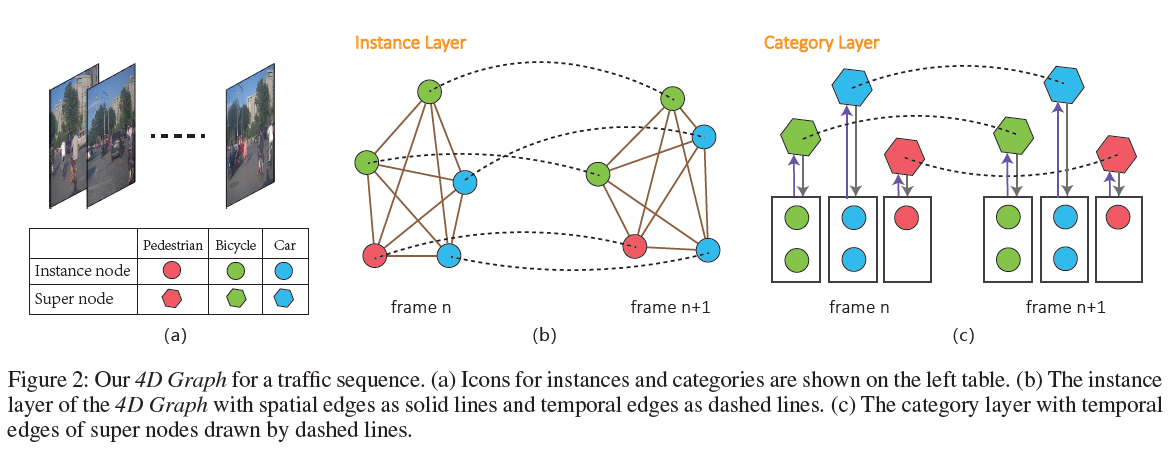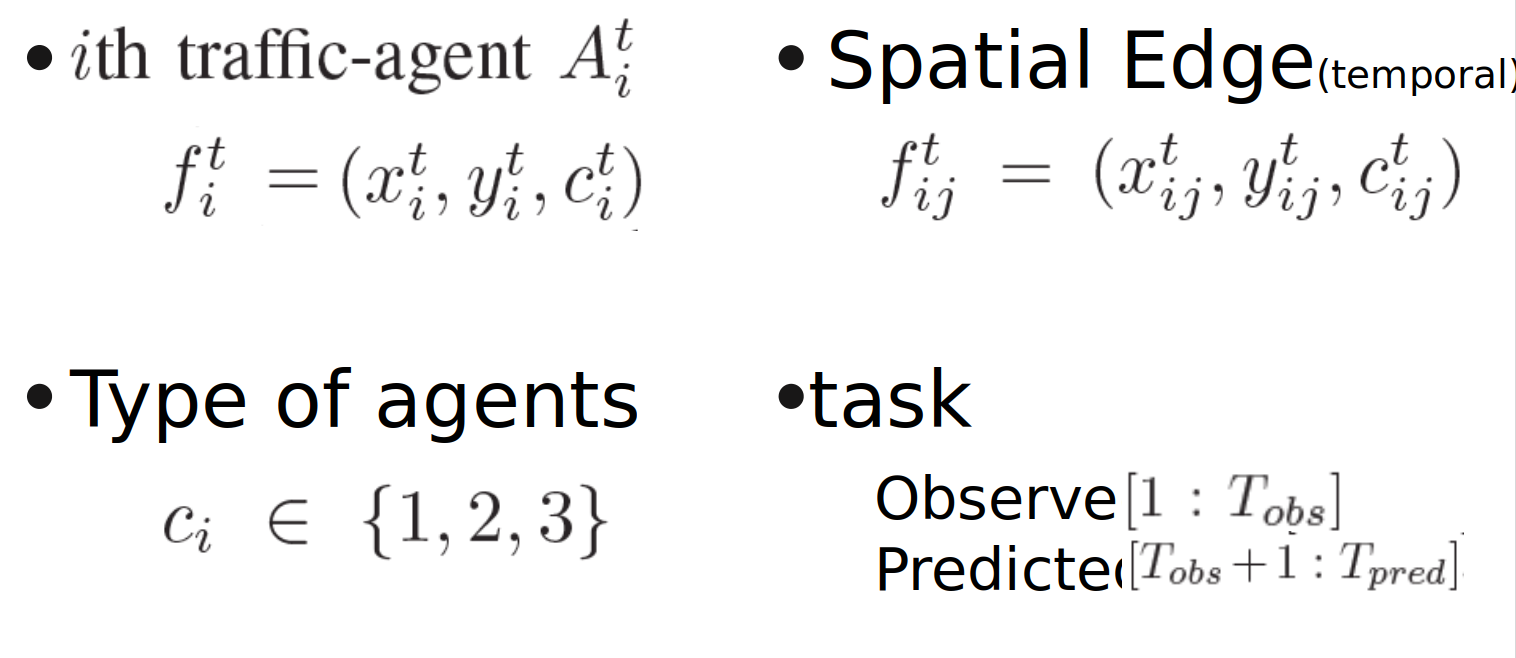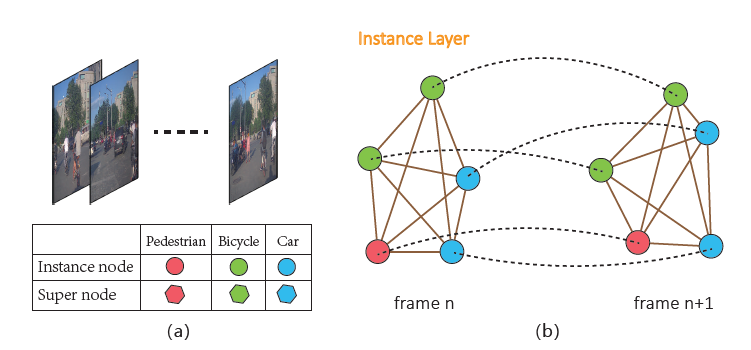論文筆記:TrafficPredict - Trajectory Prediction for Heterogeneous Traffic-Agents
前言
論文連結:TrafficPredict: Trajectory Prediction for Heterogeneous Traffic-Agents
會議:AAAI 2019
在讀這篇之前最好先讀Social Attention: Modeling Attention in Human Crowd,TrafficPredict的概念有很大一部分是從Social Attention來的,在attention的運算方面也寫的的比較詳細。
Introduction
這篇聚焦在在Heterogeneous(包含不同的agents, including vehicles, pedestrians, bikes …)上。
Main Results:
- a novel LSTM-based algorithm (new approach for trajectory prediction in heteogeneous traffic) -> 4D GRAPH
- collect a new dataset “Apollo”
- smaller prediction error
System Overview
 簡單來說勒,這篇paper主打的就是他的4D GRAPH,雖然聽起來很厲害,但其實就是4個不一樣的features而已拉,跟維度沒啥關聯。
主要分成兩個Layer:
簡單來說勒,這篇paper主打的就是他的4D GRAPH,雖然聽起來很厲害,但其實就是4個不一樣的features而已拉,跟維度沒啥關聯。
主要分成兩個Layer:
- Instance Layer:抓出(capture)instances之間的動態、互動關係
- Category Layer:歸納(conclude)類似instances的移動方式(ex:車子的移動方式、行人的移動方式)
Q:等等 那到底4D是在4D啥?
A:4D就是上面那個圖裡面的4個東東:
- 在Instance Layers中的每個instance(1st D), instance相連的spatial edge棕色線線,在空間中的關聯性(2nd D)。
- 在Category Layers中的6角形東東(high-level categorization,同一纇instance的移動特性)(3rd D)。
- frame(n) 跟 frame(n+1)之間的temperal edge虛線,時域的關聯性(4th D)。
看起來很厲害,但其實就是4種不一樣的時間、空間features而已~~~
這只是基本的部份而已,接下來還有整個的Architecture要討論。
Related Works
主要就來講一下Social Attention和Attention相關的東西。
- Social Attention(SA)
- 先來看個Social Attention(RNN-based, Homogeneous)的架構圖><,是不是跟我們的4D GRAPH超級像阿(應該有像ㄅ),只是SA沒有Category Layer的分類而已。

- 先來看個Social Attention(RNN-based, Homogeneous)的架構圖><,是不是跟我們的4D GRAPH超級像阿(應該有像ㄅ),只是SA沒有Category Layer的分類而已。
- Attention(注意力)
- 訓練讓model知道”誰是重要的”,利用公式算出一個分數,越高分則代表越重要。
- ex:在路上騎車時,正前方的車輛就很重要,因為他可能隨時會煞車、右轉等等,所以需要高注意力(attention分數高);相反的,50公尺外的行人可能就不是那麼重要(attention分數低)。簡單來說Attention就是在訓練這些東西,讓系統知道誰是該注意的東西。
Method
Problem Definition

How?(照順序來><)
先讓我們來稿清楚一下倒底用了什麼樣的LSTM
- instance LSTM(每個instance會有一個LSTM來紀錄他們的移動特性,相同種類的會share parameters,論文中提到在他們的實驗裡有3種)
- edge LSTM(找出在同一時間,instance之間的interaction)
- super node temporal LSTM
- super node LSTM
1. Instance Layer
capture the movement pattern of instances in traffic
- 利用edge LSTM抓出instance i和j的互動關係 -> (hij)
- 再來利用Attention打分數,以(hij)的結果,找出現在誰對i的重要性最大 ->(w)
- 將(w)和上一階段的結果(h2)代入istance LSTM找出第一階段的結果 -> (h1, c)
- 圖

2. Category Layer
learn the movemet from the same category of instance
- 把相同類別的instance在第一階段(instance layer)算出來的cell state(c)取出平均,以此作為該類別的移動法則(internal movement law of the trajectory) -> (F)
- 以(F)通過super node temporal LSTM計算super node時域間的特性 -> (huu)
- 以(F)、(huu)通過super node LSTM計算super node的特性 -> (hu)
- 最後以(h1)和(hu)找出最後的解答 -> (h2)
- (h2)代回instance layer作為強化
- 看圖清楚多ㄌ

3. Position Estimation
bivariate Gaussian distribution 就高斯分佈這樣
4. Loss Function

